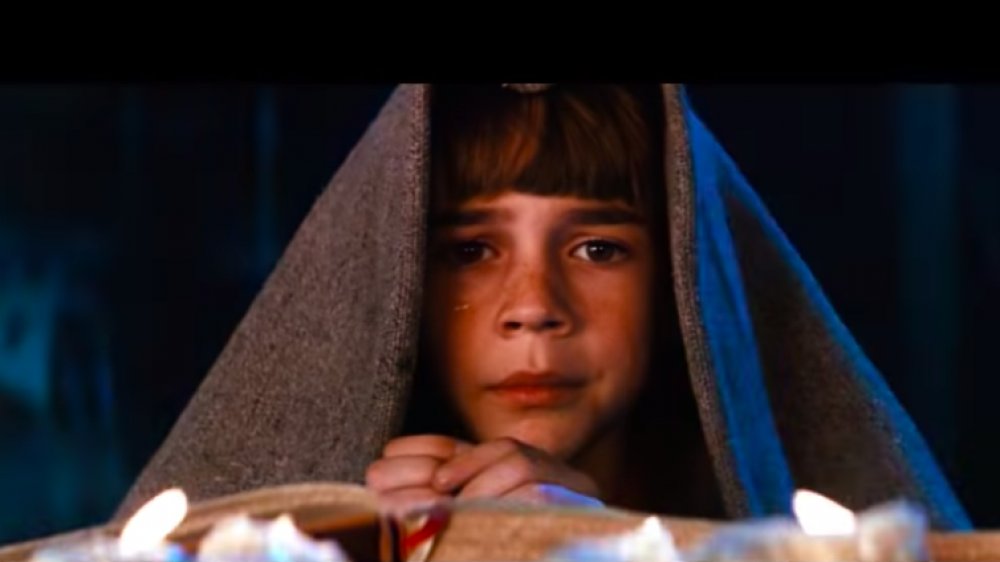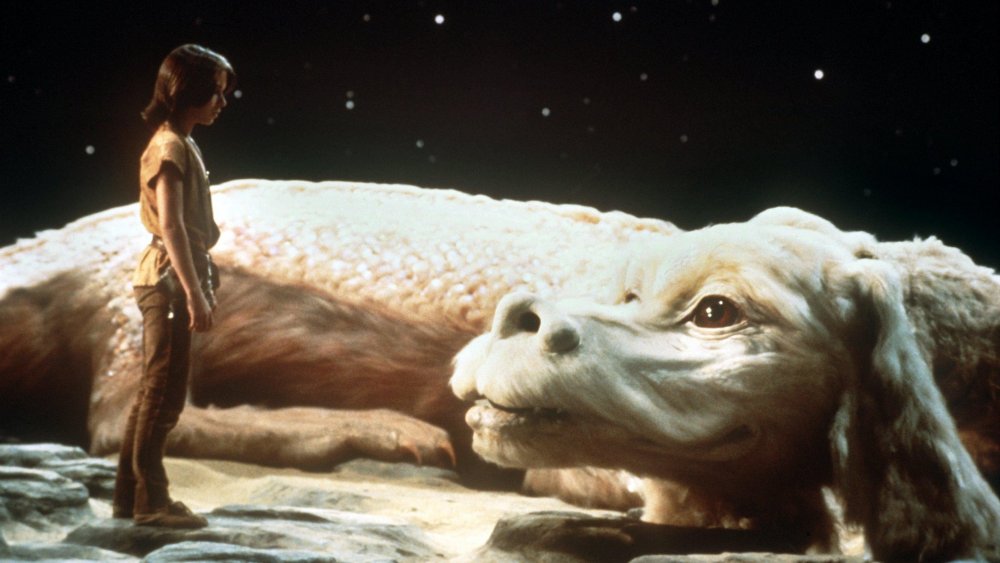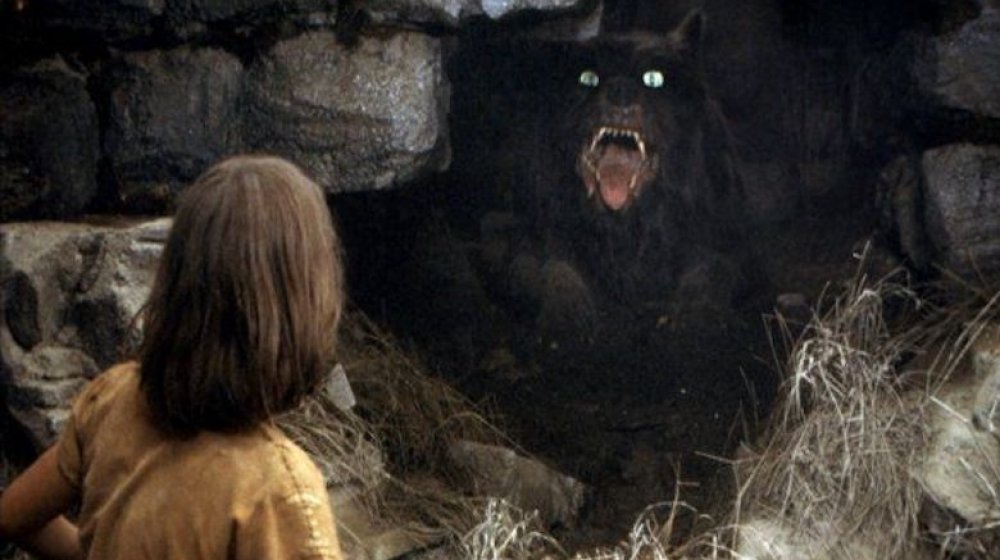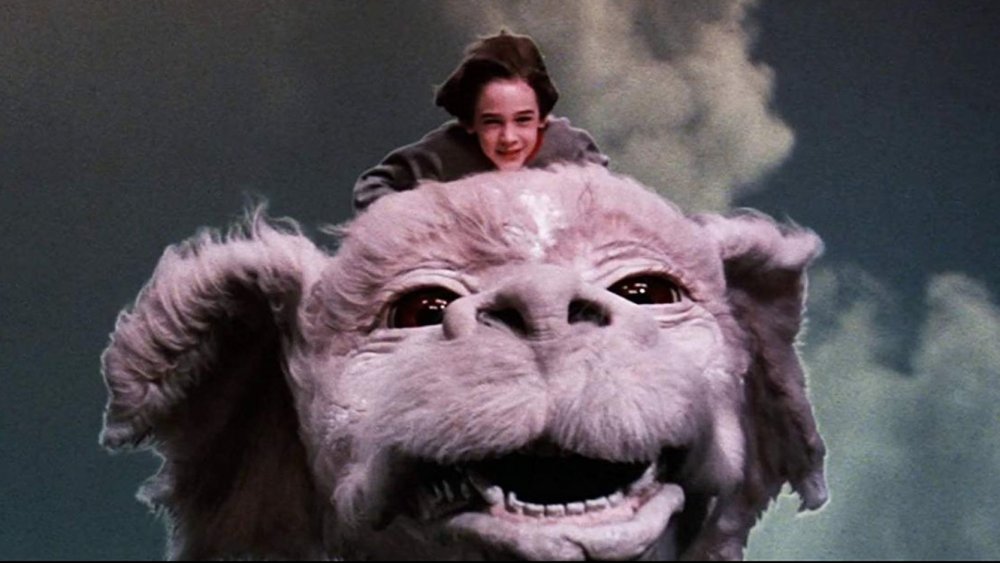Ways The NeverEnding Story Is Different From The Book
This content was paid for by Netflix and created by Looper.
The 1984 fantasy film The NeverEnding Story is a beloved modern classic that's still used as a pop-culture touchstone to this day. Take, for example, the season 3 finale of Stranger Things, which ended with Dustin and his girlfriend sweetly singing the movie's theme song, or how a flying luck dragon similar to the story's famed Falkor has made an appearance not once but twice on Fox's Family Guy. Indeed, it has proven to be an enduring adventure that continues to spark the imaginations of millions.
Based on the best-selling, critically-acclaimed 1979 novel of the same name by German author Michael Ende and translated into English by Ralph Manheim, The NeverEnding Story tells the tale of a shy, outcast boy named Bastian (Barret Oliver) who finds himself immersed in a magical book about a fantasy land that's on the brink of destruction. The movie was co-written and directed by Wolfgang Peterson, who was best known at the time for the war film Das Boot and went on to helm such blockbusters as Troy, The Perfect Storm, and Air Force One.
At the time of its release, The NeverEnding Story was the most expensive film ever produced in Germany. It went on to make a purported $100 million worldwide and spawned two sequels and an animated TV series, solidifying itself as a sentimental anchor in the hearts and minds of a generation.
While the movie uniquely captures the essence of the book, there are some subtle — and not so subtle — differences, starting with the fact that in the movie the mythical land Bastian becomes engrossed in is called Fantasia, while in the book it's Fantastica. But that's not the only variation. Here are a few more ways the NeverEnding Story differs from the book.
The NeverEnding Story only covers the first half of the book
The NeverEnding Story immortalized onscreen in the original film only tells half of the story in the book.
When we first meet Bastian, both in the movie and the book, he has taken refuge in a vintage bookstore after running away from some school bullies. There, he stumbles upon an unusual book titled The NeverEnding Story that he's instantly drawn to. After running off with it without paying, Bastian holes himself up in his school's attic to read the tale that follows a young warrior named Atreyu (Noah Hathaway) as he sets out on a treacherous journey to find a cure for the ill Childlike Empress (Tami Stronach) who rules over a fantastical land that's being destroyed by a malicious force called The Nothing.
In both the movie and the book, Bastian fervently follows Atreyu's obstacle-filled odyssey until it becomes apparent that Bastian has also become part of the narrative. He must accept that he now plays a role in The NeverEnding Story — he is the one who can save the empress. All he has to do is actively join the adventure and give her a new name, which he does. Here's where the movie ends.
But the book continues on, with Bastian getting sucked into the pages and using his imagination to shape the world around him. But every time he makes a wish, he loses an earthly memory. This leads to him down a dark path as he slowly forgets who he is and where he came from.
Enter the 1990 film The NeverEnding Story II: The Next Chapter, which tackles the second half of the book. While none of the original NeverEnding Story movie cast returns, many of the same characters are featured — including Bastian, Atreyu, the Childlike Empress, and, of course, Falkor. Meanwhile, a third film, The NeverEnding Story III: Escape From Fantasia, was released in 1994, but it follows a new story line that has nothing to do with the book.
Some of the NeverEnding Story characters look and act different in the movie
The NeverEnding Story features some of the most memorable movie characters to come out of the 1980s — what kid didn't want to take a magical ride on Falkor? But not all the characters from the film look or act exactly as they're described in the book. While these changes may seem slight, they surely affected how the film resonated with fans.
Take Falkor, for instance. In the film, the flying luck dragon resembles a charming white dog with floppy ears. In the book, Falkor looks more like a lion with large fangs, a luxuriant mane, and pointy ears. Would Falkor be as cherished if he wasn't a happy-go-lucky dog with his tongue flopping out of his mouth? It's certainly up for debate.
Other examples include the appearances of Bastian and Atreyu. In the book Bastian is a pale, pudgy kid with glasses who's embarrassed by his looks. But in the movie, he's slim, cute, and glasses-free. Another slight change was that Atreyu had green skin in the book — not a big deal, right? But making him look more human in the film made him a little more accessible to viewers.
But bodily characteristics aren't the only area where change is obvious. One example of a significant character shift is with Artax, Atreyu's trusty horse, who talks in the book but doesn't onscreen. Still, the death of Artax in the Swamps of Sadness is certainly one of the more distressing moments in the film. In fact, somehow the situation is even more dire considering the white steed can't express himself as he sinks slowly into the mud and eventually disappears.
While the nuances of Artax's death differ — in the book, instead of silently sinking into the swamp, Artax tells Atreyu to leave him behind rather than watch him die — the end result is the same. Before this incident, the idea that the magical land is being sucked into The Nothing is fairly abstract. But once Atreyu experiences a personal loss, he finds a new motivation — and so does the observer.
The Nothing that overtakes The NeverEnding Story is much more complex in the book
In the movie The NeverEnding Story, The Nothing that's swallowing up Fantasia is depicted as a storm, with dark clouds swirling in the sky sweeping up everything in its path. No more forests, no more creatures, not even a dried-up lake...just nothing is left behind. According to the sinister wolf-like creature Gmork, who has been tasked with tracking down and killing Atreyu, The Nothing was created from people in the human world who have no hopes or dreams, no imagination, and that emptiness and despair is what's destroying Fantasia, since the magical land was initially created from human fantasy.
But in the book, Gmork knows this because he is a servant of the power behind the Nothing: a group of antagonists called The Manipulators who are unique to the book. And if Gmork succeeds in killing Atreyu, people will have no hope, and people with no hope are easy to control — and The Manipulators are looking to control the human race. The Nothing not only destroys Fantastica but when it surrounds people who have lost faith and given up hope, they surrender themselves into oblivion by jumping right into it. Once they are swallowed up, they are reborn in the human world as lies, which creates despair and gives The Manipulators more power.
While The Nothing succeeds in destroying the land and all it encompasses, Bastian creates a new version of the world by using his imagination.
The ending of The NeverEnding Story deviates from the book
Obviously, the main difference when it comes to the ending of the NeverEnding Story movie versus the book is that the film effectively lops off half the story. But within that truncated ending, there is still a slight difference as to how we get to the film's conclusion. Where the book is able to introduce a multitude of characters and meander through several layers of storytelling, the film is much more streamlined.
The climax comes when Bastion realizes he is part of the story that he's reading — the characters are actually speaking directly to him through the pages — and Atreyu's whole journey was a way to suck him into the book and fuel his imagination. He soon finds out that he is the key to saving Fantasia, and all he has to do is give the Childlike Empress a new name. Until he does that, the all-consuming Nothing will swallow up the fanciful land that Bastian has come to love until everything's gone.
In the film, Bastion realizes his purpose through a little coaxing from the empress, who makes it clear that the boy reading the book is her savior. In the book, it's a much more roundabout journey for Bastion and the empress. She must go on her own expedition to find the Old Man of Wandering Mountain, who tells her the story Bastian just read — and is now part of — will endlessly repeat until Bastian understands his role. Therefore, Bastian reads the same story over and over until he finally understands the part he plays. Both scenarios end with him saving the land by calling out a new name for the empress: Moon Child.
The last scenes of the film are of Bastian using his imagination to rebuild Fantasia — the land is lush again, Atreyu and Artax are reunited, and, most importantly, Bastian gets to take a triumphant ride on Falkor. If you want to know what happens beyond this, you'll just have to watch The NeverEnding Story II: The Next Chapter.



